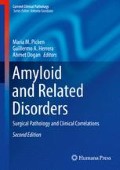Abstract
Serum- and urine-based laboratory testing are important initial observations in helping to guide both the differential diagnosis of primary amyloidosis (AL) and the testing for identifying and characterizing tissue amyloid. The fibrils in AL are derived from intact or fragmented monoclonal immunoglobulin light chains. These patients have intact free monoclonal immunoglobulin and/or free immunoglobulin light chains detected in the serum and/or urine. The purpose of this chapter is to describe the methods used to detect plasma cell proliferation disorders and to identify excess monoclonal free light chain (FLC) synthesis. Specifically, the value of protein electrophoresis (PEL), immunofixation electrophoresis (IFE), and quantitative serum FLC)analysis will be presented. These tests are not only useful in the differential diagnosis of amyloidosis but also have a role in early disease detection, prognosis, and monitoring of AL.
Access this chapter
Tax calculation will be finalised at checkout
Purchases are for personal use only
References
Kyle RA, et al. Prevalence of monoclonal gammopathy of undetermined significance. N Engl J Med. 2006;354(13):1362–9.
Kyle RA, et al. A long-term study of prognosis in monoclonal gammopathy of undetermined significance. N Engl J Med. 2002;346(8):564–9.
Landgren O, et al. Risk of monoclonal gammopathy of undetermined significance (MGUS) and subsequent multiple myeloma among African American and white veterans in the United States. Blood. 2006;107(3):904–6.
Rajkumar SV, Gertz MA, Kyle RA. Primary systemic amyloidosis with delayed progression to multiple myeloma. Cancer. 1998;82(8):1501–5.
Madan S, et al. Clinical features and treatment response of light chain (AL) amyloidosis diagnosed in patients with previous diagnosis of multiple myeloma. Mayo Clin Proc. 2010;85(3):232–8.
Steensma DP. “Congo” red: out of Africa? Arch Pathol Lab Med. 2001;125(2):250–2.
Hoffman JE, Hassoun H, Landau H, Comenzo RL. Coincindal gammopathies in patients with systemic amyloidosis and transthyretin gene mutations. Proceedings of the 52nd ASH annual meeting, Orlando, FL; 2010.
Strege RJ, Saeger W, Linke RP. Diagnosis and immunohistochemical classification of systemic amyloidosis. Report of 43 cases in an unselected autopsy series. Virchows Arch. 1998;433(1):19–27.
Gertz MA, Lacy MQ, Dispenzieri A. Amyloidosis: recognition, confirmation, prognosis, and therapy. Mayo Clin Proc. 1999;74(5):490–4.
Bradwell AR, et al. Highly sensitive, automated immunoassay for immunoglobulin free light chains in serum and urine. Clin Chem. 2001;47(4):673–80.
Katzmann JA, et al. Serum reference intervals and diagnostic ranges for free kappa and free lambda immunoglobulin light chains: relative sensitivity for detection of monoclonal light chains. Clin Chem. 2002;48(9):1437–44.
Barnidge DR, et al. Using mass spectrometry to monitor monoclonal immunoglobulins in patients with a monoclonal gammopathy. J Proteome Res. 2014;13(3):1419–27.
Drayson M, et al. Serum free light-chain measurements for identifying and monitoring patients with nonsecretory multiple myeloma. Blood. 2001;97(9):2900–2.
Lachmann HJ, et al. Outcome in systemic AL amyloidosis in relation to changes in concentration of circulating free immunoglobulin light chains following chemotherapy. Br J Haematol. 2003;122(1):78–84.
Abraham RS, et al. Quantitative analysis of serum free light chains. A new marker for the diagnostic evaluation of primary systemic amyloidosis. Am J Clin Pathol. 2003;119(2):274–8.
Dispenzieri A, et al. Absolute values of immunoglobulin free light chains are prognostic in patients with primary systemic amyloidosis undergoing peripheral blood stem cell transplantation. Blood. 2006;107(8):3378–83.
Katzmann JA, et al. Diagnostic performance of quantitative kappa and lambda free light chain assays in clinical practice. Clin Chem. 2005;51(5):878–81.
Bradwell AR, et al. Serum test for assessment of patients with Bence Jones myeloma. Lancet. 2003;361(9356):489–91.
Katzmann JA, et al. Elimination of the need for urine studies in the screening algorithm for monoclonal gammopathies by using serum immunofixation and free light chain assays. Mayo Clin Proc. 2006;81(12):1575–8.
Palladini G, et al. Identification of amyloidogenic light chains requires the combination of serum-free light chain assay with immunofixation of serum and urine. Clin Chem. 2009;55(3):499–504.
Katzmann JA. Screening panels for monoclonal gammopathies: time to change. Clin Biochem Rev. 2009;30(3):105–11.
Dispenzieri A, et al. Prevalence and risk of progression of light-chain monoclonal gammopathy of undetermined significance: a retrospective population-based cohort study. Lancet. 2010;375(9727):1721–8.
Gertz MA, et al. Definition of organ involvement and treatment response in immunoglobulin light chain amyloidosis (AL): a consensus opinion from the 10th international symposium on amyloid and amyloidosis, Tours, France, 18–22 April 2004. Am J Hematol. 2005;79(4):319–28.
Kumar SK, et al. Changes in serum-free light chain rather than intact monoclonal immunoglobulin levels predicts outcome following therapy in primary amyloidosis. Am J Hematol. 2011;86(3):251–5.
Kumar S, et al. Serum immunoglobulin free light-chain measurement in primary amyloidosis: prognostic value and correlations with clinical features. Blood. 2010;116(24):5126–9.
Yamamoto K, et al. The amyloid fibrils of the constant domain of immunoglobulin light chain. FEBS Lett. 2010;584(15):3348–53.
Klimtchuk ES, et al. The critical role of the constant region in thermal stability and aggregation of amyloidogenic immunoglobulin light chain. Biochemistry. 2010;49(45):9848–57.
Author information
Authors and Affiliations
Corresponding author
Editor information
Editors and Affiliations
Rights and permissions
Copyright information
© 2015 Springer International Publishing Switzerland
About this chapter
Cite this chapter
Murray, D.L., Katzmann, J.A. (2015). Laboratory Support for Diagnosis of Amyloidosis. In: Picken, M., Herrera, G., Dogan, A. (eds) Amyloid and Related Disorders. Current Clinical Pathology. Humana Press, Cham. https://doi.org/10.1007/978-3-319-19294-9_25
Download citation
DOI: https://doi.org/10.1007/978-3-319-19294-9_25
Publisher Name: Humana Press, Cham
Print ISBN: 978-3-319-19293-2
Online ISBN: 978-3-319-19294-9
eBook Packages: MedicineMedicine (R0)

